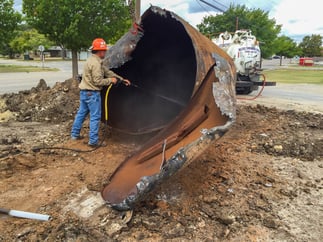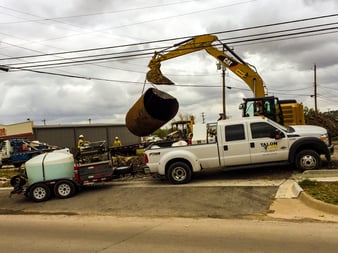Many landowners across the state are discovering that underground storage tanks (UST) located on their land are not in compliance with recently enhanced environmental protection standards. Property  owners opting to simply remove these tanks altogether as a remedy to this problem need to be aware
owners opting to simply remove these tanks altogether as a remedy to this problem need to be aware
that there are strict, legally binding regulations in-place overseeing such procedures.
The Environmental Protection Agency (EPA) works closely with state bureaus to ensure that during underground storage tank removal procedures the appropriate safety and monitoring protocols are observed to establish that hazardous materials are neither spilled, nor discovered to have already leaked, posing a threat to public groundwater.
Why Remove an Underground Storage Tank
The principal danger posed by the presence of unused USTs derives from the possibility that it could still leak or spill hazardous substances into the surrounding soil with the potential to contaminate nearby groundwater. It is therefore highly recommended by environmental experts that USTs which are no longer being used, should be removed.
EPA regulations are in-place to assure that if there is a release of a hazardous substance, it must be detected and quantitatively assessed. Also, a landowner will be required to submit a removal plan to either the EPA or their respective state environmental protection agency which must include:
-
how precisely you will remove your UST
-
nature of the substances it had contained
-
profile of the backfill materials and adjacent soils
-
determination of the presence of groundwater – its depth and location relative to the surface and UST
Once an underground storage tank removal plan has been approved, though, there are still a number requirements that environmental regulations require be followed during the actual work of getting it out of the ground.
Removal Process Requirements
In a state like Texas, for example, the Texas Commission on Environmental Quality (TCEQ) has established a detailed set of quality controls and safety measures that must be adhered to during all underground storage tank removal projects. These consist of such measures as:
-
individuals who conduct the removal procedure are required to be licensed by the TCEQ
-
the business or organization performing the removal must be registered with the TCEQ
-
notification of TCEQ – in writing - at least 30 days prior the removal
-
emptying of the UST of all regulated materials, the removal of accumulated sludge, and the purging of any vapors present
-
emptying, disconnecting, and plugging of all piping and associated devices
-
physical removal of the UST from the site within 24 hours
Additionally, there are a number of accompanying issues and technical considerations to be aware of:

-
specified signage guidelines that must be inscribed on the removed tanks to warn against using them for storing anything destined for human consumption
-
detailed record keeping requirements
-
soil sampling procedures to insure that a leak has not already occurred
-
there are serious dangers associated with the removal process itself, including both fire and explosion hazards
In other words, underground storage tank removal is much more than simply digging it out of the ground and hauling it away. Careful procedures have been put in-place that are designed to protect against the pollution of any groundwater in the vicinity. Following these procedures is a legal requirement.
Due to the existence of such a detailed and comprehensive set of requirements surrounding UST removal, many land owners when confronted with compliance issues on unused tanks are opting to contract environmental services professional to handle the details of the removal process.
Talon/LPE is licensed with state agencies and can help you with your underground storage tank. Contact Talon/LPE today and we will complete the paperwork, perform the removal, and provide regulatory correspondence.


